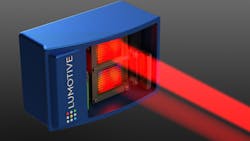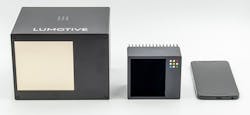Solid-State LiDAR Leverages Liquid-Crystal Metasurfaces, CMOS Manufacturing
This article is part of the TechXchange: LIDAR Technology
LiDAR perception sensors for advanced driver-assistance systems (ADAS) and the emerging self-driving car industry are used for detection, localization, and classification of objects at long distances (up 200 m). LiDAR is typically employed for pedestrian identification, collision avoidance, and emergency braking. The challenge of developing LiDAR for these applications is balancing performance, measured by range, resolution, and frame rate, with commercial viability, whose metrics include size, reliability, and cost.
With its first commercial solid-state LiDAR sensors, startup company Lumotive (Seattle, Wash.) has introduced a proprietary beamsteering technology based on a liquid-crystal metasurface (LCM). It reflects the emitted beam in the desired direction, resulting in a fully solid-state solution and in turn promising high performance along with commercial viability.
LCMs are a new class of optical devices based on two-dimensional arrays of subwavelength optical elements. When modulated by an electrical signal, the liquid crystals change their index of refraction, which then changes the amount of delay photons experience between entering the nanoscale resonators and being re-emitted from the resonators. Consequently, each resonator acts as a programmable phase-delay element.
No Moving Parts
As such, Lumotive’s technology is similar to phased-array radar—an electronically scanned computer-controlled series of antennas that creates a beam of radio waves that can be electronically steered to point in different directions without moving the antennas. Lumotive points out that its LCM technology thus enables the construction of LiDAR sensors without moving parts.
The absence of moving parts makes the construct potentially more reliable, compact and, according to Lumotive, more cost-effective than those using a mechanical beamsteering system. The LCMs are fabricated from silicon in a CMOS foundry using conventional materials and patterning processes. The liquid crystals are applied to the surface of the chips and sealed with a cover glass during packaging in the same manner as in liquid crystal on silicon (LCOS) display assembly. Standard LCD drivers are then attached, which provide the voltages to drive the resonators.
Lumotive’s LiDAR system contains two LCMs, one each for transmitting and receiving (Fig. 1). The switching speed of the Lumotive LCM is about 25 μs when using conventional liquid crystals, which is considerably faster than the millisecond switching speeds typical of LCOS and liquid-crystal displays (LCDs).
Aperture
Automotive LiDAR systems are difficult to design because they require a large aperture size and expanded field of view. A large optical aperture is essential because on the receiving end, aperture size determines the light-gathering capability of the system and therefore drives the range, resolution, and frame rate. A large aperture also makes it possible to transmit a more powerful laser beam without exceeding the power density threshold for eye safety. In legacy mechanical scanning systems based on MEMS mirrors, as aperture size increases, the field of view decreases.
On the Lumotive LCM, tuning the liquid-crystal coating on the metasurface steers the beam over a 120- × 30-degree field of view with uniform efficiency and an aperture of up to 25 × 25 m. The large aperture of the new LCM beamsteering technology thereby permits greater range and more efficient implementation.
Lumotive has patented its solid-state beamsteering technology, which the company says meets the range, field-of-view, resolution, and size.
The firm announced the first two 3D-sensing products that utilize its LCMs, the X20 and Z20 LiDAR systems, targeting the automotive and industrial automation markets, respectively. The X20 enables automotive applications with a range of over 120 meters (Fig. 2). The Z20 sensor will have a shorter—about 50 m—range, but with a vertical aperture angle of 70 degrees, it’s well-suited to various industrial applications. Lumotive’s M20, addressing the needs of the consumer and mobile markets, will be introduced in 2021.
“We know that one size doesn’t fit all when deploying 3D sensing in different applications, and our underlying architecture allows us to efficiently scale the technology to meet specific market requirements while maintaining the cost benefits we achieve through our manufacturing approach” says Dr. William Colleran, Lumotive co-founder and CEO.
These LiDAR systems integrate modules for transmit, receive, and beamsteering, which may be purchased by automotive tier-1 suppliers and industrial sensor product vendors seeking to enhance their own LiDAR offerings.
“The LiDAR markets dedicated to ADAS and robotic car applications are showing significant growth between 2019 and 2025, from US$117 million to US$2.3 billion,” says Alexis Debray, Technology & Market Analyst at the market research and strategy consulting company Yole Développement. Yole estimates the CAGR for LiDAR markets during this period will reach almost 64%.
Check out more content from the TechXchange: LIDAR Technology


